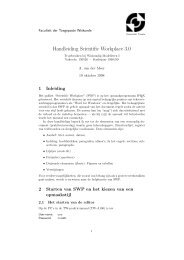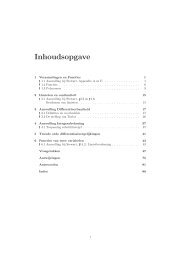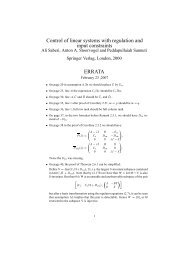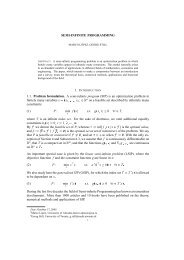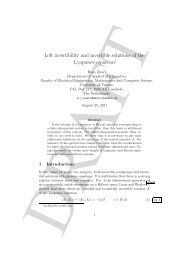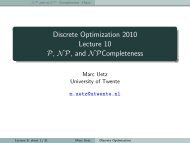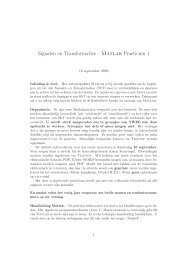Is Aâ1 an infinitesimal generator?â - Applied Mathematics
Is Aâ1 an infinitesimal generator?â - Applied Mathematics
Is Aâ1 an infinitesimal generator?â - Applied Mathematics
You also want an ePaper? Increase the reach of your titles
YUMPU automatically turns print PDFs into web optimized ePapers that Google loves.
Proof. We again concentrate on the integral term in (11). We have that, using property c.,∫ ∞0‖τh ac (tτ)T (t)x 0 ‖dt≤≤∫ ∞0∫ ∞Mτ|h ac (tτ)|Me −ωt ‖x 0 ‖dt0M 2= MM 2 ‖x 0 ‖τ 1 4τ(tτ) 3/4 e−ωt ‖x 0 ‖dt∫ ∞= MM 2 ‖x 0 ‖τ 1 π √ 24ω 1 4 Γ( 3 4 ).Combining this inequality with equation (11), we see that (15) holds.01t 3/4 e−ωt dtExample 3.5. In our example we take X = C 0 (0, 1), i.e., the space of all continuous functionson [0, 1), which have limit zero at one. This is a B<strong>an</strong>ach space under the supremum norm.On this state space we choose as semigroup{f(t + η) t + η ∈ [0, 1)(T (t)f) (η) =(16)0 t + η ≥ 1It is not hard to see that this is a strongly continuous semigroup on X with ‖T (t)‖ ≤ 1, <strong>an</strong>dT (t) = 0 for t ≥ 1. So it is a contraction semigroup with growth bound minus infinity. Inparticular, the semigroup is exponentially stable.From Lemma 3.2 we have that( )∫ 1−ηe A−1τ f (η) = f(η) − τh ac (tτ)f(t + η)dt= f(η) −0∫ (1−η)τ0( ) ˜th ac (˜t)fτ + η d˜t. (17)By constructing a suitable sequence of functions f’s, we show that ‖e A−1τ ‖ behaves like 4√ τ.Therefore we fix τ.Let φ ε be a continuous function on R which is positive, bounded by one, φ ε (0) = 0, <strong>an</strong>dφ ε (t) = 1 for |t| ≥ ε. Furthermore, define ψ τ be a continuous function on [0, ∞) which ispositive, bounded by one, ψ τ (t) = 0 for t ≥ τ, <strong>an</strong>d ψ τ (t) = 1 for t < τ − 1.Let t k , k = 1, . . . , K be the zeros of h ac in [0, τ].[ K]∏g ε (t) = φ ε (t − t k ) sign(h ac (t))ψ τ (t), t ≥ 0.k=1It is not hard to see that g ε is continuous on [0, ∞) with g ε (t) = 0 for t ≥ τ <strong>an</strong>d sup t≥0 |g ε (t)| =1. Hence f(t) := −g ε (t/τ) is <strong>an</strong> element of X with norm one.Next choose in equation (17) η = 0 <strong>an</strong>d f(t) = −g ε (τt), then( )∫ τ( ) ˜te A−1τ f (0) = f(0) − h ac (˜t)f0 τ + 0 d˜t∫≥ f(0) +|h ac (˜t)|d˜t.DRAFT{˜t∈[0,τ−1]||˜t−t k |≥ɛ, for k=1,...K}8



